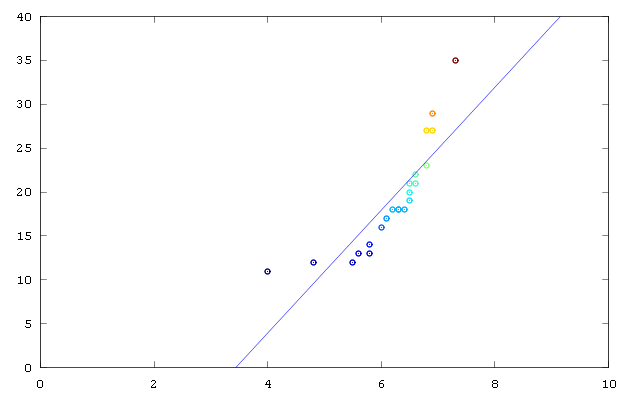Difference between revisions of "Korelácie"
From RoboWiki
| (2 intermediate revisions by the same user not shown) | |||
| Line 7: | Line 7: | ||
b) extract files from [http://www.dpmi.tugraz.at/schloegl/matlab/NaN/NaN.zip NaNnnn.tar.gz] and move them into | b) extract files from [http://www.dpmi.tugraz.at/schloegl/matlab/NaN/NaN.zip NaNnnn.tar.gz] and move them into | ||
| − | .../octave/.../m/statistics/base/ | + | <TT>.../octave/.../m/statistics/base/ </TT> |
| − | c) (re-)start Octave and run | + | c) (re-)start Octave and run <TT>naninsttest</TT>. |
This checks whether all previous functions have been replaced | This checks whether all previous functions have been replaced | ||
| Line 31: | Line 31: | ||
[[Image:ScatterPlot.png]] | [[Image:ScatterPlot.png]] | ||
| + | |||
| + | Data Set 3: | ||
| + | |||
| + | [[Media:Cities.mat]] | ||
'''scatterplotf.m''' | '''scatterplotf.m''' | ||
| Line 49: | Line 53: | ||
</source> | </source> | ||
| + | |||
| + | Pokračovanie: [[PCA analýza akčných potenciálov]] | ||
Latest revision as of 11:15, 12 November 2008
The NaN-toolbox: A statistic-toolbox for Octave and Matlab which handles data with and without MISSING VALUES encoded as NaN's.
Installing the NaN-tb with Octave:
a) You need repmat.mrepmat.m (e.g. from P.Kienzle's MATCOMPAT)
b) extract files from NaNnnn.tar.gz and move them into .../octave/.../m/statistics/base/
c) (re-)start Octave and run naninsttest. This checks whether all previous functions have been replaced
Data Set 1:
X = [4.4 5.5 4.2 3.0 4.5 4.9 4.6 5.0 4.7 5.1 4.4 4.1 4.9 4.7 5.0 4.6 3.6 4.9 5.1 4.8 5.2 5.2]'; Y = [12 14 18 35 23 29 16 12 18 21 27 13 19 22 20 16 27 21 13 18 17 11]'; scatter (x, y, [], sqrt(x.^2 + y.^2));
Data Set 2:
V = [5.8 7.3 5.6 4.0 6.0 6.5 6.2 6.6 6.3 6.8 5.8 5.5 6.5 6.3 6.6 6.1 4.8 6.5 6.8 6.4 6.9 6.9]'; T = [13 35 13 11 16 19 18 21 18 27 14 12 21 18 22 17 12 20 23 18 27 29]'; scatter (V, T, 5, sqrt(V.^2 + T.^2)); axis ([0 10 0 40]
Data Set 3:
scatterplotf.m
function ret=scatterplotf(x,y)
[m,n]=size(y);
if m==1,
y=y';
x=x';
end
dispmat=[x y];
n=size(dispmat,2);
dispmat=sortrows(dispmat,1);
x=dispmat(:,1);
y=dispmat(:,2:n);
plot(x,y);
endfunction
Pokračovanie: PCA analýza akčných potenciálov
